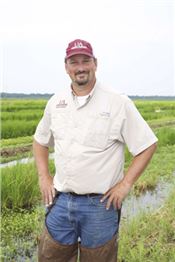|
New Rice Chemistries Brighten Horizon For Growers

Dr. Jason Norsworthy, weed scientist with the University of Arkansas,
speaks about a new compound for rice set to debut in a
couple of years.
Photo by John LaRose, Jr.
BETTY VALLE GEGG-NAEGER
MidAmerica Farmer Grower
STUTTGART, ARK.
Scientists are very excited about a new compound, benzoicyclon, an HPPD herbicide for rice set to debut in a couple of years, according to Dr. Jason Norsworthy, weed scientist with the University of Arkansas. He talked about the chemical at the rice field day at Stuttgart, Arkansas.
“The beauty of this herbicide is it’s one that actually can provide control of several of the resistant weeds that we currently have,” he said. “ALS resistant rice flatsedge and smallflower umbrellasedge, are major problems for us in the state of Arkansas and this product does a very good job on them. Actually, this product will be sold as a premix with the herbicide Permit, and Gowan Chemical Company will be bringing this compound forward. The product they will market will likely have the trade name Rogue.”
In addition to the weeds just mentioned, benzoicyclon provides very good control of most aquatic weeds such as ducksalad, arrowhead and sprangletop in rice. One of the most exciting things with this product that has been observed this year is it’s actually able to take weedy rice out of conventional rice.
“We hope that feature will be reproducable for multiple years,” Norsworthy continued. “As far as I am aware, this is the first herbicide that literally can remove weedy rice from conventional rice without a trait being involved.
“I think the future looks very bright for this herbicide. It’s going to be a product we’re going to have to put into the rice once we flood the fields. It will not be in rice prior to a flooding, but overall we’re very excited that this product brings a new mode of action to us in rice and it’s going to control many of the problem weeds that we currently have.”
The next herbicide he discussed was pethoxamid, which is also a new chemistry. It’s referred to as a chloroacetamide in rice, very similar to Dual use in soybean, cotton and corn. This is a herbicide that provides good residual control of annual grasses. He pointed to a field on his right where that chemical was used.
“It will kill rice or control rice if we actually apply it at planting and that’s actually the beauty of the compound,” Norsworthy said. “When we come over the top of rice, it’s not going to be effective on that rice but it will kill any weedy rice that has not yet germinated or emerged. This is a new tool that we’re very excited about and, similar to the previous compound that I spoke about, we’re probably two to three years from actually having this product at market.”
A third product, Rinskor, a Dow AgroSciences compound, should be available in the next couple of years. This is a unique herbicide for rice, it’s one that controls propanil-resistant, Facet-resistant, Command-resistant as well as ALS-resistant barnyardgrass.
“This herbicide has very good activity on a wide assortment of weeds when we actually apply it immediately prior to flooding,” he said. “Again, it has good grass control as well as good activity on several sedges and many of the broadleaf weeds that we typically have in rice.”
These chemicals will be part of a program approach to managing weeds in rice, but each will bring another unique mode of action to the program.
“The fourth compound that I’d like to talk about is Provisia,” Norsworthy said. “Provisia is a BASF herbicide, and it is one that is going to be specific to controlling grasses. It will provide good control of weedy rice, barnyardgrass and all the other annual grasses that we have within rice. It’s not going to have any activity on the broadleaf weeds; hence, we’re going to use tank mixtures with some broadleaf products to pick up a wide array of weeds.
“I think the beauty of the Provisia system is it’s going to help us out on some of the resistant issues that we have, specifically barnyardgrass as well as the weedy rice issues that we’re dealing with throughout the midsouth.”
He stressed his take-home message that there will be four new herbicides coming for rice, with three of those having unique chemistries or unique modes of action that have not yet been used in rice.
“I think that is very exciting because most of the resistant weeds that we’re dealing with, we’re are up against the wall from the standpoint of not having any new chemistry,” he said. “It’s an exciting time because soon we will have four new herbicides, three new chemistries to help us with our battle with resistance. Up until this point, we really have been losing the battle of resistance especially with the barnyardgrass, considering the fact we have five modes of action for which we had resistance and there have been scarey times up until this point. So I’m excited about the future, I think the future is very bright for rice and we can’t wait to get these products to market. ∆
BETTY VALLE GEGG-NAEGER: Senior Staff Writer, MidAmerica Farmer Grower
|
|